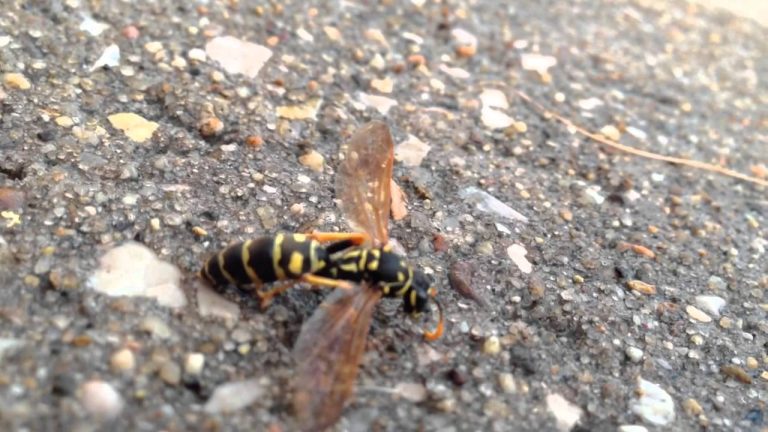Seeing a wasp struggling on the ground can stir up mixed feelings. Our first instinct may be to get rid of the potential sting hazard. But taking a moment to assist an ailing pollinator can be rewarding. Here is a step-by-step guide on how to safely save a dying wasp.
Assess the Situation
The first step is to carefully watch the bug to see if it really needs help or is just taking a break. A healthy wasp will look alert, and if you get too close, it might fly away. Someone who is dying might move slowly or erratically, have trouble flying, or not move at all. As well, look for signs of harm, such as a hurt wing or leg or an enlarged stomach.
Keep your distance to avoid getting stung by a wasp that still has some fight left! Only try to help if you can do so safely without much risk of being stung.
Create a Safe Space
If the wasp is inside, gently guide it onto a sheet of paper or flat surface using cardboard. Avoid touching it directly. Then move it away from high traffic areas to a quiet spot.
If you find a struggling wasp outside, make a protected area by placing an overturned cup or bowl over it. This gets it off the ground and out of harm’s way. Just don’t trap it fully inside. Prop up one edge of the cover to allow air flow.
Offer Sustenance
Insects need food and water to live, just like people do. Give the sick wasp some sugar to help it feel better. Mix up a solution of sugar or honey and water. Put a small drop near the bug but not on it. To avoid touching it, use an eye dropper, toothpick, or other disposable tool.
If possible, position the drop to contact the mouthparts or antennae to encourage feeding. Give the wasp time to ingest the fuel. You may need to reapply the solution periodically. The sugar will provide much-needed energy.
Keep It Warm
Insects can’t regulate their body temperature. Being outside in the cold can quickly drain their already low energy stores. If you want to bring a wasp back to life on a cool day, put a lamp or other gentle heat source close by but not touching it. The added warmth can help its chances.
Allow Time to Recuperate
Allow the sick wasp enough time to digest the sugar water, get warm, and get its strength back. Keep an eye out for signs of recovery, such as more movement, alertness, grooming, or attempts to fly. It could take anywhere from 10 minutes to a few hours to do this.
Check on its status periodically, but avoid too much disruption. If there’s no improvement after a long wait, the wasp likely has an underlying issue that basic first aid can’t fix.
Release Back Outside
Once the wasp seems re-energized and able to fly well, carefully relocate it back outside. Use your cardboard guide to gently encourage it onto a flower, leaf, or other safe landing spot. This gives it the best chance to be on its way.
While not every rescue attempt may work, a few thoughtful actions on our part can go a long way toward potentially saving an important pollinator. Always be extremely careful when working near stinging insects. But consider lending a careful helping hand next time you find a wasp in need. Your efforts could make all the difference!
Frequently Asked Questions
Here are answers to some common questions about saving dying wasps:
How to help a dead wasp?
If the wasp is already dead, place it in your freezer for at least 2 hours to ensure it is no longer a sting risk. Remember that even a dead wasp’s sting can penetrate skin, so handle dead wasps carefully.
Why is a wasp not moving?
Wasps and many insects move slowly or not at all when they are cold. Cool nights, especially in early morning before the day warms up, can cause wasps to become sluggish.
Should you save wasps?
Yes, wasps play a beneficial role in suppressing many insect pests, so the goal should be to reduce encounters with them, not eliminate them entirely. Wasps are predators that eat ticks and other insects like houseflies.
How do you kill a wasp humanely?
To humanely kill a wasp, a quick, forceful smack with a flyswatter can dispatch it in one blow. You can also spray it directly with soapy water, which will coat its breathing pores and cause relatively quick death. Riskier options are trying to step on it or swatting it mid-air.
How long does a wasp sting last?
A normal wasp sting will cause pain, redness, swelling, and itching at the site for a few hours up to a couple days. Most symptoms gradually improve within the first 24 hours. However, severe allergic reactions can occur, leading to more serious, prolonged symptoms needing immediate medical care.
Are there dead wasps in your home?
Lethargic wasps in your home are likely male wasps that have died naturally or hibernating female wasps. This often happens during winter months and indicates a nest exists somewhere close by.
How long does it take a wasp to die naturally?
If trapped indoors, wasps typically die within a few weeks to several months. If outdoors, they usually perish within 1-2 days since the rest of the colony will have left by that point.
With some basic knowledge and a gentle helping hand, you can assist distressed wasps and give them a fighting chance to carry on their vital work as pollinators and pest controllers. Approach the situation calmly, act thoughtfully, and who knows – you may end up saving a life!

